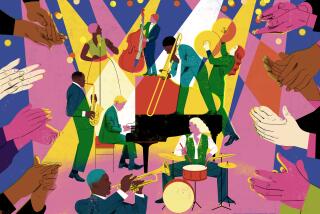For Charles Owens, it’s all about jazz
Saxist Charles Owens is going blue for the senior citizens. Blue notes, blue humor.
“A dirty mind is a good thing at any age,” chuckled Owens, introducing a breezy R&B hip-shaker called “Funk It” at a daytime retirement-community performance in downtown Los Angeles sponsored by the Angeles Plaza Entertainment Committee. “We ain’t dead yet!”
Owens, 74, means to include jazz itself among the unentombed. The seniors quit text-messaging to clap rhythm in agreement, and Owens’ all-ages quintet proceeded to augment standards such as “Misty” and “Take the ‘A’ Train” with perky Latin grooves and gutty blues, all featuring his own challenging tenor runs and atomized tones. Dead? Ain’t.
At home, Owens’ heavily scribbled wall calendar bears similar testimony. Just back from Europe with the Clayton-Hamilton Jazz Orchestra, Owens is gearing up rehearsals with Cal State L.A.’s Luckman Jazz Orchestra, which he has conducted for the last four years. He’s got gigs in the Valley and Hermosa Beach with his two working groups. And he’s teaching three jazz ensembles weekly at UC Irvine and UCLA.
“Teaching is really cool,” says Owens in a Central Los Angeles living room appointed with his signifiers: African-themed art, a Bible on the table, a play area for his visiting grandkids. “It’s taken the place of the club jam session. For a long time I didn’t think you could learn jazz in a college situation — I thought it was bullcorn.”
Today, Owens withdraws the epithet: “I’ve had four or five students that I would put up against anybody.” Many a music geek would flash on the names of Owens’ sax pupils, such as Azar Lawrence (Earth, Wind & Fire, Miles Davis), Louis Van Taylor (Ray Charles, the Gap Band) and Kamasi Washington (Gerald Wilson, Snoop Dogg).
Owens contracted the teaching bug in the 1980s as part of the Wind College, a crucial L.A. institution whose small but stellar faculty also included clarinetist-composer John Carter, flutist-composer James Newton and legendary bassist Red Callender.
Owens saw the need: He’d picked up his own jazz chops on the street. For technical foundation, he credits his training in the public schools of his native San Diego as well as at San Diego State and at Houston’s Prairie View A&M. But none of his instructors knew of Charlie Parker or Thelonious Monk until he studied with Joe Viola at Boston’s Berklee College of Music.
May 10, 1971, sticks in Owens’ mind, the day he moved to Los Angeles. Fresh out of Mongo Santamaria’s Afro-Cuban band, he’d been lured toward L.A.’s boiling studio scene by the musicians he’d met along the way — saxist Don Menza, saxist Ernie Watts, bassist Howard Rumsey.
And they were right — Owens’ skill and versatility (the Musicians Union certifies him in 10 woodwinds) got him work with artists such as mainstream balladeer Barbra Streisand and soul titan Isaac Hayes.
Some gigs, such as his alliance with pianist, composer and community leader Horace Tapscott, engaged more than Owens’ wallet. He could search the reaches of his improvisational imagination while observing the effect Tapscott had visiting schools, playing senior centers and seeding youth into his Pan Afrikan Peoples Arkestra.
It was inspiring. Owens remembers a Leimert Park performance of the Arkestra not long before Tapscott’s 1999 death. “He had cancer, and he couldn’t move one arm. About halfway through, he was conducting with both hands — it was amazing. And when it was over, he couldn’t move his arm again! I never will forget that.”
All Owens’ lessons converge when he conducts the Luckman Jazz Orchestra. His predecessor, James Newton, left the post four years ago to concentrate on composing but tabbed Owens as the ideal successor. Newton calls Owens “one of Los Angeles’ true artistic treasures” and praises “the ability to integrate the fullness of the jazz tradition with his modernist propensities.”
The tradition more than lives in the Luckman Jazz Orchestra. The unit often mines the compositions of a jazz great — Duke Ellington, Charles Mingus, Eric Dolphy — to spark loose-limbed expressions of its own members’ and arrangers’ distinctive personalities.
“My main job is keeping all these great musicians inspired and not getting in their way,” says Owens, who has directed luminaries such as windman Bennie Maupin, drummer Alphonse Mouzon and percussionist Ndugu Chancler. “Each time you hear us, it’s a fresh approach to the tunes.”
Freshness means a lot to Owens; without it, jazz would rot. So although most of his club work veers toward standards, he nurtures his links to ever-questing explorers such as John Coltrane and Ornette Coleman.
“Their spiritual side hooked me. Even now, Coltrane’s ‘A Love Supreme’ just touches me. You can tell when somebody means what they’re playing. That’s my thing! I have to hide it sometimes, because I’ve emptied a lot of clubs through my Coltrane impersonation!”
Owens has experimented with fingerings, taught himself to play two saxes at once and mastered the technique of circular breathing, all because he sensed the existence of undiscovered notes and sounds. “Unless I’m screechin’ and reachin’, I’ll never find ‘em.
“I’m more determined, more dedicated and more qualified to bring jazz to the world today than I ever have been — that’s what motivates me to get out of bed.”
Owens uses the word “joy” a lot. It’s also the title of his wide-ranging 2010 album, recorded by classic engineer Rudy Van Gelder and featuring supermen Ron Carter, Mulgrew Miller and Lewis Nash.
“I go to bed thinking about music, and I wake up thinking about music. If I wasn’t getting paid for it, I’d be doing the same thing! So I’m very lucky and blessed.”
A luckman, you might say.
More to Read
The biggest entertainment stories
Get our big stories about Hollywood, film, television, music, arts, culture and more right in your inbox as soon as they publish.
You may occasionally receive promotional content from the Los Angeles Times.






